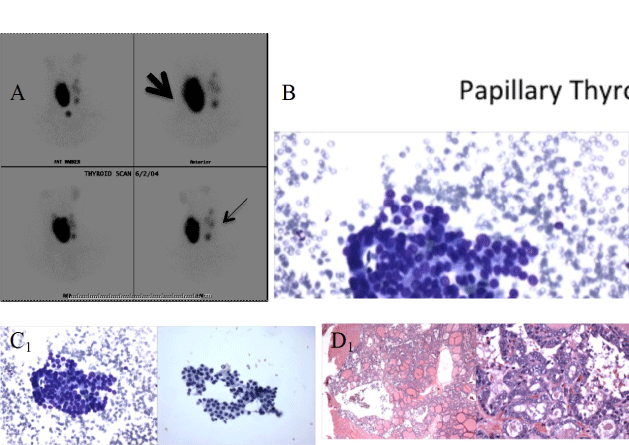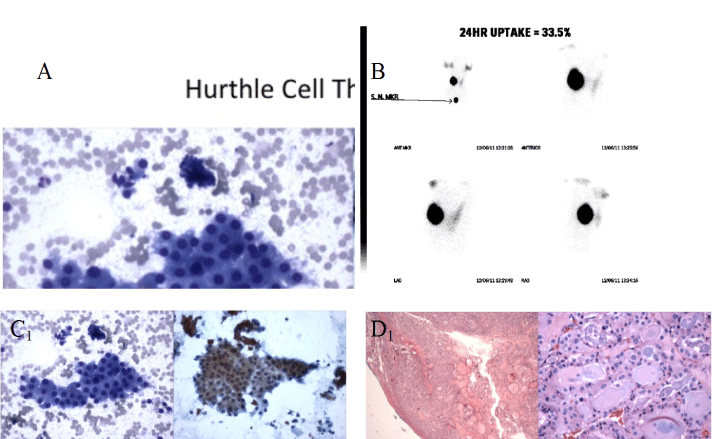Research Article Open Access
Correlation of Hot Nodules and Cytopathology: Nine Years at an Academic Institution
| Mehdi Djekidel1*, Guoping Cai2, Rafay Ahmed1 and Constantine Theoharis2 | |
| 1Department of Diagnostic Radiology, Yale University School of Medicine, USA | |
| 2Department of Pathology, Yale University School of Medicine, USA | |
| Corresponding Author : | Mehdi Djekidel Department of Diagnostic Radiology Yale University School of Medicine 310 Cedar Street, New Haven, CT 06520, USA Tel: 203-200-5180 E-mail: mehdi.djekidel@yale.edu |
| Received April 28, 2014; Accepted May 14, 2014; Published May 21, 2014 | |
| Citation: Djekidel M, Cai G, Ahmed R, Theoharis C (2014) Correlation of Hot Nodules and Cytopathology: Nine Years at an Academic Institution. OMICS J Radiol 3:162. doi:10.4172/2167-7964.1000162 | |
| Copyright: © 2014 Djekidel M, et al. This is an open-access article distributed under the terms of the Creative Commons Attribution License, which permits unrestricted use, distribution, and reproduction in any medium, provided the original author and source are credited. | |
Visit for more related articles at Journal of Radiology
Abstract
Background: Thyroid nodules are frequently diagnosed in everyday clinical practice. Strategies for the evaluation of their potential malignant risk and clinical management approaches have been widely developed by multiple endocrine and surgical societies. These guidelines are dynamically changing and the malignant potential of a hot thyroid nodule has become a matter of debate.
Methods: All thyroid scans (n=137) performed at our institution over nine years (January 2003 to December 2012), for which a cytopathology result was available for review were retrospectively reanalyzed by an experienced nuclear medicine physician. 65 scans demonstrated clearly hot nodules and were correlated with cytopathology results.
Results: Only one of sixty-five nodules (1.5%) was found to be malignant: a Hürthle cell carcinoma. An additional papillary thyroid carcinoma was found incidentally in another patient, however corresponding to a cold nodule in the contralateral lobe to the hot nodule.
Conclusions: A hot nodule on a thyroid scan likely confers an overall low but non-negligible risk for malignancy. Further studies on larger datasets pooled from various centers would be valuable.
| Keywords |
| Hot nodule; Malignancy; FNA; Cytology; Thyroid scan |
| Introduction |
| Benign thyroid nodules are frequent in the general population, however, thyroid cancer, the most common endocrine malignancy, has been increasing in incidence over the last few decades throughout the Western World [1-4]. Imaging has assessed noninvasively the malignant risk of thyroid nodules either be solitary nodules or part of a multinodular goiter. If they exhibit suspicious characteristics on ultrasound, or appear “cold” i.e. non-functioning (without uptake) on a thyroid nuclear scan, they have been associated with a higher risk of malignancy [5,6]. Suspicious nodules traditionally undergo fine needle aspiration for cytology review and/or surgical resection. A hemi or total thyroidectomy will then be performed [7]. On the other hand, autonomous hyperfunctioning nodules i.e. that show uptake and appear “hot” on a nuclear thyroid scan have been regarded as having a very low but undefined malignant risk [8]. However, there have been a few recent reports describing a possible malignant association with hot nodules on a thyroid scan [9-13]. We conducted a retrospective analysis in order to better ascertain the potential malignant risk of a hot nodule. |
| Methods |
| The archives of the Yale Department of Diagnostic Radiology were reviewed and all thyroid nuclear medicine scans performed over the past nine years (January 2003 to December 2012) were extracted and reanalyzed. A total of 137 thyroid nodules were identified for which cytopathology FNA correlation existed. 137 scans were then retrospectively re-analyzed by an experienced nuclear medicine physician. Final cytopathology diagnoses were then reviewed and correlated to the nodules identified on the thyroid scan. Procedure dates, biopsy sites, cytologic FNA findings and/or surgical specimen histology were additionally recorded and correlated with the thyroid nuclear scan findings. |
| Thyroid scans were performed as per a routine protocol. A 100-microcurie dose of 123I was used for 24 hour uptake measurements. Immediately following the iodine uptake measurement, a thyroid scan was performed 20 minutes after the injection of 10 mCi of 99mTc-pertechnetate. This protocol offering the best image quality, most accurate uptake measurement and lowest radiation dosimetry compared to a higher dose iodine only uptake and scan protocol. |
| Fine-needle aspiration biopsies were performed almost entirely via ultrasound. Each sample was evaluated via smears stained with either the Diff-Quik stain or via the Papanicolau method. Needle washes were performed and evaluated via ThinPrep processing. |
| Surgical histologic samples were processed via conventional buffered formalin preservation and Hematoxylin/Eosin staining. |
| Results |
| Our patient population was overwhelmingly female (61:4). Mean age was 50.9 ± 16.7. Table 1 describes the results. 65 of the 137 nodules (47%) were hyper-functioning “hot” nodules. Of our 65 scans with hot nodules, 14 (21%) of them additionally had a cold nodule usually in the contralateral lobe. |
| 53 (81%) of patients additionally showed evidence of definite suppression of the remainder of their thyroid gland. The average uptake value was 25% (± 13%). |
| 25% (16/63) of the patients had abnormal uptake values defined as ≥ 30%. While 3% (2/65) of the patients had no uptake measurement performed. |
| Only 25% (16/65) of the cohort underwent surgical resection, usually for a Goiter. All except 4 patients had an FNA performed who instead underwent a surgical resection as the initial diagnostic step. 3% (2/65) of cases were malignant. However, in one case, we found that a papillary micro carcinoma involved a lobe contralateral to the hot nodule on the nuclear scan, so the cancer did not correlate to a hot nodule. It should be noted however that a second nodule, this one “cold” (nonfunctioning), had been identified in this same patient corresponding to the microcarcinoma as shown in Figure 1. The second patient found to have a malignancy had a surgical resection revealing Hürthle cell carcinoma corresponding to the hot nodule as seen in Figure 2. The tumor was large, at least 3 cm in size on postoperative histologic evaluation. Furthermore, the patient was found to be hyperthyroid with a low TSH, with abnormal values ranging between 0.005-0.0010 mIU/l (Normal: 0.5-4.5 mIU/l). |
| Discussion |
| Hot nodules are believed to possess a low risk of malignancy and ATA guidelines do not recommend an aggressive approach to management. Additionally patients with a low TSH (similar to our patient) are felt to also be of low risk [7]. Our data supports the hot nodule expectation as only 1 patient (1.5%) had a malignancy corresponding to a hot nodule in our cohort. This patient surprisingly also had a low TSH. The malignant potential of a hot nodule in our limited population (n=65) is therefore low. However, this low rate is not negligible, and a few authors have reported a possible malignant association of hot nodules [9-13]. Polyzos et al. also had found an incidental thyroid carcinoma in the contralateral lobe as in our series [11]. The ATA guidelines state that a hyperfunctioning or hot nodule on scintigraphy may be treated non-surgically if the patient is clinically hyperthyroid or euthyroid. Our single Hürthle cell cancer patient was hyperthyroid. The size of the nodule however was clinically concerning. Our patient’s nodule was larger than 3 cm. This is noteworthy as this was also the case of several malignant hot nodules reported in the literature. The size of a hot nodule may be a satisfactory criterion to decide of its malignant potential. TSH status is not supported in our limited study. |
| Clinicians are frequently faced with the dilemma of thyroid nodule characterization and the estimation of a malignant risk. This risk can then be conveyed to the patient and translated into a medical management decision. Our data and the hot nodule literature support a low malignant risk. However, this risk may be altered in larger nodules. |
| Conclusion |
| A hot nodule on a thyroid scan may overall confer a low risk for malignancy (1.5%). Evaluation of size (>3 cm) may improve the diagnosis of malignancy in hot nodules in selected cases. Further studies on larger datasets pooled from various centers would be valuable. |
References |
|
Tables and Figures at a glance
| Table 1 |
Figures at a glance
 |
 |
| Figure 1 | Figure 2 |
Relevant Topics
- Abdominal Radiology
- AI in Radiology
- Breast Imaging
- Cardiovascular Radiology
- Chest Radiology
- Clinical Radiology
- CT Imaging
- Diagnostic Radiology
- Emergency Radiology
- Fluoroscopy Radiology
- General Radiology
- Genitourinary Radiology
- Interventional Radiology Techniques
- Mammography
- Minimal Invasive surgery
- Musculoskeletal Radiology
- Neuroradiology
- Neuroradiology Advances
- Oral and Maxillofacial Radiology
- Radiography
- Radiology Imaging
- Surgical Radiology
- Tele Radiology
- Therapeutic Radiology
Recommended Journals
Article Tools
Article Usage
- Total views: 13944
- [From(publication date):
September-2014 - Jul 12, 2025] - Breakdown by view type
- HTML page views : 9344
- PDF downloads : 4600
